It is essential to keep your tires adequately filled with air. Underinflated tires can suffer from overheating, uneven wear and less efficiency. However, it can sometimes be inconvenient to take your flat tires to a professional. In that case, it is helpful to know how to fill a tire using an air compressor on your own.
The first step is to make sure you have the correct tools for the job. Otherwise, you won’t be able to safely and effectively fill your tire to the proper specifications. You will need several tools, including:
The two most common types of tires you can fill at home with an air compressor are car and bike tires. You can also use an air compressor to fill the tires of dirt bikes, lawnmowers, tractors and other equipment. Here are the basic steps for filling tires with an air compressor:
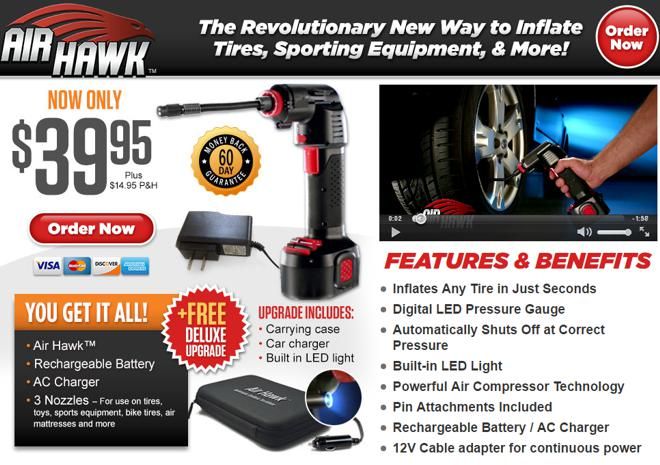
While the basic method of filling tires is the same, knowing how to fill a bike tire with an air compressor is slightly different from a car tire. There are several variations, including:
Understanding these differences is vital in knowing how to service your bike tire with an air compressor.
Air compressors can help refill tires on cars, bikes and other equipment. There are some differences across each tire type, but the process is mostly the same. With Quincy Compressor, you can find the perfect air compressor to fill up any of your flat tires on your own. Contact us today for more information, or explore our portable air compressor options!
There are some differences across each tire type, but the process is mostly the same. With Quincy Compressor, you can find the perfect air compressor to fill up any of your flat tires on your own. Contact us today for more information, or explore our portable air compressor options!
Getting a flat tire is usually an unexpected, inconvenient experience, but it is also a fairly common one. No car owner is immune from this experience, and most drivers will endure this at some point in their years of driving.
Maintaining correct tire pressure is the first line of defense against finding yourself stranded with a flat tire. It is essential for the lifespan and performance of your tires, and although there are many other ways you could get a flat tire, at least if you do this right, you will know it wasn’t your fault.
It’s easy to check your tire pressure at a filling station, of course, but it’s even easier if you can do it yourself, whenever necessary, without the hassle of driving anywhere. If you own an air compressor, or if you’re thinking of getting one, then checking your tires, or inflating them after a flat, is as easy as 1, 2, 3… Quite literally.
If you own an air compressor, or if you’re thinking of getting one, then checking your tires, or inflating them after a flat, is as easy as 1, 2, 3… Quite literally.
Read on to learn how to use an air compressor to inflate your tires, and maintain perfect tire pressure at all times.
The air pressure requirements of tires vary greatly between vehicle types and tire types. It is also affected by the load of the vehicle, and the weather.
An air compressor can be used for many different types of tires, so you may find you have more than one use for one in your home. They can inflate tires on cars, bicycles, motorbikes, tractors, trailers, and even certain mowers.
What this means is that you will need to know the requirements of the specific tires you want to inflate, before you get started with your air compressor.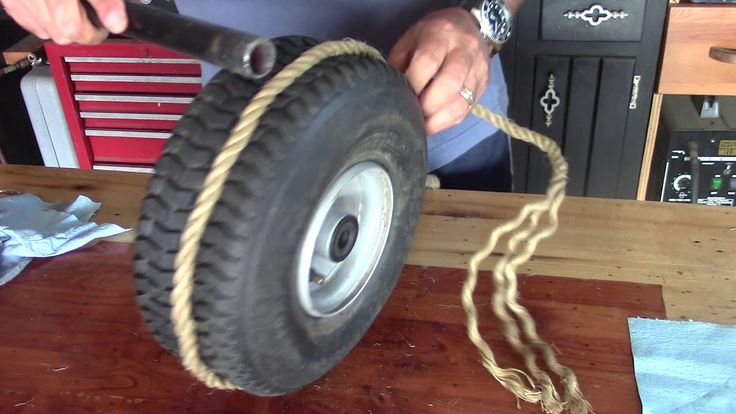
Be sure to read the owner’s manual of the vehicle in question, to ensure you know what pressure the tires on that vehicle should be inflated to, and if the front and back tires should be the same, or different.
In cars and other larger vehicles, you may find the recommended air pressure printed on a sticker inside the driver’s side door. You should never use the “per square inch” (PSI) number on the wall of the tire, as this is the maximum pressure the tire can withstand, not the optimal pressure for best performance and safety. It can, however, be used to decide which type of air compressor to buy for your vehicle.
These are the max PSI values, not the recommended PSI values.The most common tire pressure requirements are 30 PSI in summer, and 35 PSI in winter, but these are not correct for every vehicle, so be sure to find out about your specific one.
Remember that the colder it gets, the higher you may need to inflate your tires, so if you live in an extremely cold area, be sure to find out the correct tire pressure for your vehicle at the temperatures you are experiencing.
It is best to inflate your tires when they are cold, and your car hasn’t been driven in the last 30 minutes, at least. Hot tires tend to show higher pressure on the tire gauge than is realistic (because the hot air expands), and you will not get an accurate reading.
Each tire on your vehicle should have a stem cap on the valve stem. Remove the stem cap, and put it somewhere safe, so that you can return it when you are done. It may be best to do this only after you have set up the air compressor so that you don’t lose any air before you are ready to inflate the tire.
Situate your air compressor as near to the tire you want to work with as possible. You don’t want to have to move a vehicle when it has a flat or very low tire. Attach the hose to the compressor, and the quick coupler, or tire chuck, to the end. This will allow you to push air into the valve stem. If the nozzle has a safety position, activate it now.
Most air compressors are electric, so be sure there is a power source nearby, and check that the outlet has the correct voltage for your machine. Connect the compressor, secure the hose to the tire’s valve stem, and turn on the machine. You will hear the motor start, and the compressor will fill with air.
Inflating a very flat tire could take some time, and is, in any case, best done slowly. This way, you will avoid overinflating the tire. Some compressors will have a gauge, which you can use for guidance, and some inflators can be set to switch themselves off when the tire reaches the desired PSI.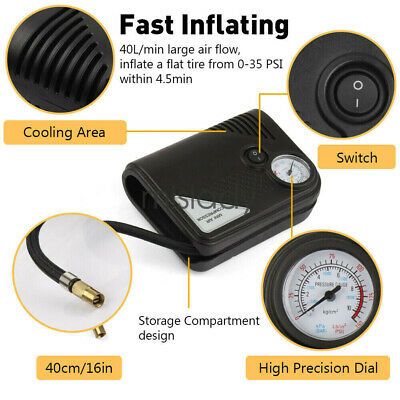
The most accurate inflators tend to be digital. Note that you should never leave a machine unattended while it is inflating a tire, even if it is set to switch itself off. Overinflating the tire could lead to serious damage.
If you are working with a thinner tire, like a motorbike tire, you may need an adaptor for the tire chuck. You should also remember that, if your bike has one thin and one thick tire, they will have different pressure requirements. Be sure to fill motorbike tires very slowly, as they can easily explode if overinflated.
Assuming that you do not have a digital or automatic inflator, keep a close eye on the tire pressure, and switch off the air compressor as soon as the desired pressure is reached. If you find that you have added too much air, simply push down on the tire gauge to release some pressure.
When the pressure is correct, remove the hose, and replace the stem cap. It is normal to hear air hissing out when removing the hose, so do not be alarmed.
Related: Putting Air In Your Tires At A Gas Station: The Complete Guide
If you find yourself in a situation where you have tires with low pressure, and no way to inflate them at hand, you will have to drive your vehicle at least a short distance to reach the nearest filling station. In this instance, be sure to:
Now you know how to inflate your tires with an air compressor, here are a few common errors that keep people from doing this job themselves, or having optimally cared-for tires:

The problem of depressurization of pneumatic tires, has not yet been solved. Therefore, the question of how to pump up a car wheel with a compressor remains relevant. It's always annoying to find your car with a flat tire. We must hurry on business, and then there is this misfortune. Regular use of the electric pump makes the driver trained. But the rare use of a compressor, or a complete lack of experience, can puzzle the car owner.
Car compressor for inflating wheels, is an electric motor with a piston and a cylinder. To supply power to the electric pump motor, a long wire with a plug is used. The design of the plug is designed for quick connection to the cigarette lighter socket. Simply plug into the cigarette lighter and then press the toggle switch on the compressor. Everything should work.
To supply power to the electric pump motor, a long wire with a plug is used. The design of the plug is designed for quick connection to the cigarette lighter socket. Simply plug into the cigarette lighter and then press the toggle switch on the compressor. Everything should work.
What if the cigarette lighter does not work? A new nuisance appears due to a blown fuse. You can open the fuse box and check the elements for the integrity of the threads. If the reason turned out to be this, then this is easily fixed by installing a new fuse.
The cigarette lighter continues to refuse to work, and there is no time to search for the causes of the problem. You will have to connect the compressor directly to the battery. To do this, cut the plug from the cable. Next, strip the ends of the wires so that the strand can be looped around your finger. These will be the clamps. We dress improvised terminals on the battery (red wire "+", black "-"). We turn on the compressor.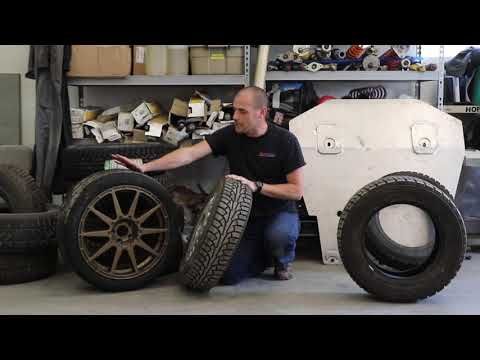 If the battery is old, it is recommended to pump the wheels with the engine running. In the future, after repairing the cigarette lighter, the cut off plug must be connected to the cable, and the wire twists must be insulated.
If the battery is old, it is recommended to pump the wheels with the engine running. In the future, after repairing the cigarette lighter, the cut off plug must be connected to the cable, and the wire twists must be insulated.
If there is a compressor, but there is no experience of pumping wheels, then exercises should be carried out. To do this, it is enough to know the rules that will help you act in a certain sequence:
Pump hose end with lock. In the vertical position, the valve is closed and the tip is ready to be fitted onto the wheel fitting. After moving the lever to a horizontal position, the tip is fixed on the fitting, opening the nipple for air supply.
In the vertical position, the valve is closed and the tip is ready to be fitted onto the wheel fitting. After moving the lever to a horizontal position, the tip is fixed on the fitting, opening the nipple for air supply.
Each car is designed to use a specific tire size. In addition, tires must have working pressure. To inform the car owner about the type of tires and the air rate, the automaker sticks an information label in the driver's doorway. Sometimes, a decal is placed in the passenger doorway. The content is arranged in the form of a table, which will indicate different pressures in the wheels for winter and summer operation.
Do not wait until the air has completely leaked from the wheels. It is recommended to check the sufficiency of tire pressure every two weeks. This will reduce rubber wear, since even minus 0.5 atm. reduces the life of tires, especially the side profile. In addition, weak tires lead to an increase in fuel consumption, as they are less resistant to rolling resistance. Along with this, under-inflated tires are prone to the formation of hernias. And yet, a weak wheel harms the suspension, not to mention the deterioration of the car's directional stability on the track.
In addition, weak tires lead to an increase in fuel consumption, as they are less resistant to rolling resistance. Along with this, under-inflated tires are prone to the formation of hernias. And yet, a weak wheel harms the suspension, not to mention the deterioration of the car's directional stability on the track.
Train yourself to look after the condition of your tires. A simple operation to inspect the wheels and measure the pressure with a pressure gauge can delay the purchase of new wheels for a couple of seasons. And this is a significant savings in the personal budget.
Contents
It is the responsibility of the owner to keep the vehicle in good technical condition at all times. In this case, do not forget about the wheels, because there are many ways to maintain proper pressure in them. Find out how to pump up a car tire with a compressor, pump, and other strange ways.
In this case, do not forget about the wheels, because there are many ways to maintain proper pressure in them. Find out how to pump up a car tire with a compressor, pump, and other strange ways.
With the development of modern technology, the compressor has finally replaced conventional pumps. The current situation is explained by the ease and rapid application of the appropriate device.
When choosing a product, first of all, pay attention to the wire, which in relatively inexpensive models is powered by the cigarette lighter. As for products of a higher class, they are powered by a battery.
Once you have figured out where to insert the connector, connect the wire to keep the compressor running smoothly.
Then tightly connect the compressor hose and the car wheel nipple by screwing. In some models, this will require considerable physical effort. At the same time, information about the current tire pressure status will appear on the pressure gauge. This information is needed to designate pressure limits.
At the most critical stage, set the compressor switch to the operating mode. If you did everything right, the tires of the car will start to swing automatically. Do not leave this process unattended, because it is absolutely undesirable to overdo it and pump the wheel over the prescribed volume. A manometer will help check the number of atmospheres. He defines them very precisely.
Those who don't like pumping wheels themselves should pay attention to tubeless tires. After all, their main advantage is that when they are punctured, they remain inflated for a long time. Thus, pressure and traffic safety is maintained.
Modern gas stations, in addition to filling the tank with fuel, provide the possibility of solving the problem of a flat tire.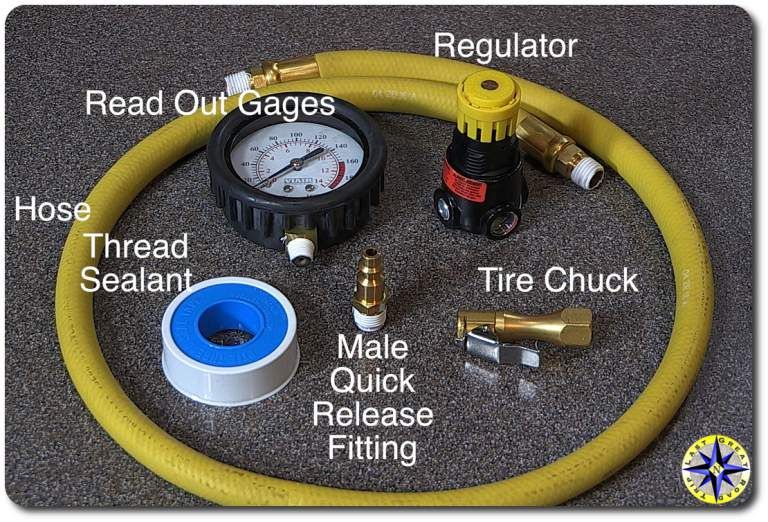 Today you need to know how to pump up a car wheel at a gas station.
Today you need to know how to pump up a car wheel at a gas station.
Many gas stations have specially designated places for this. If you are on the road for a long time, do not hesitate to stop by there. The service is provided absolutely free of charge. There can also be no doubt about the accuracy of the regular refueling pressure gauge.
The rules and procedure for pumping up wheels at a gas station are practically no different from the conditions of a garage or car service. Be sure to turn off the engine and follow the procedure already described with accuracy.
[totalpoll id=”5531″]
The gas station compressor has been upgraded and therefore has a built-in pressure gauge and other settings as an add-on. This is explained by the fact that gas stations are considered to be specialized places for this procedure.
Wheel inflation station at a gas station Start inflating tires by setting a suitable pressure and turn on the device.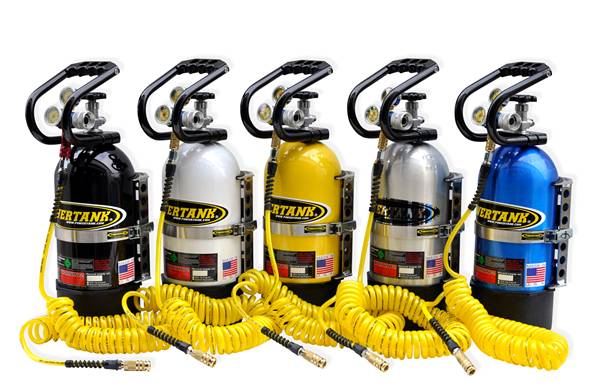 Built-in automation will do everything on its own in compliance with all safety measures.
Built-in automation will do everything on its own in compliance with all safety measures.
The compressor is usually located on the side of the end of the building. The vehicle must be placed in such a way that the hose reaches absolutely all the wheels without any difficulty.
Remember that it is possible to inflate tires on a vehicle without a pump.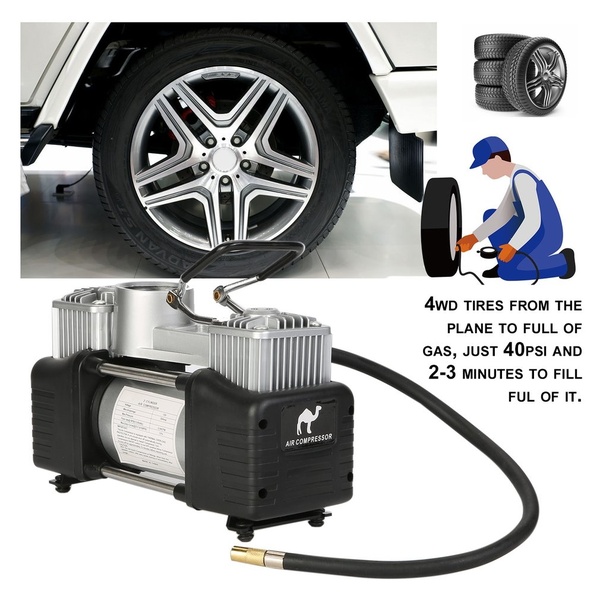 Let's see how these options work.
Let's see how these options work.
For example, you can use turbocharging, the essence of which is to connect a hose to the air path after the turbocharger. The network says that it will go in an emergency, but in fact the boost pressure between the compressor and the intake valves of the engines is completely insufficient to inflate the tire.
In the right hands, the turbocharger can be used to inflate the wheelsAn aerosol can can also be used. Similar ones are usually available from the masters involved in the hardware of gadgets. Such devices are used to clean systems and boards from dust. The procedure is similar: you need to attach a can of liquid to the nipple and press it. In this way, you can pump up the wheel, but it will take a lot of spray cans. Impractical and expensive.
Aerosol can be used for tire inflation If a fire extinguisher is available, it can also be used. The pressure in the wheel rises by a couple of bars, but from the inside .